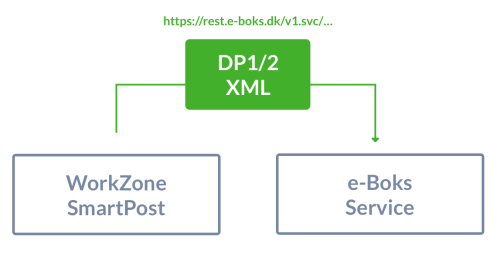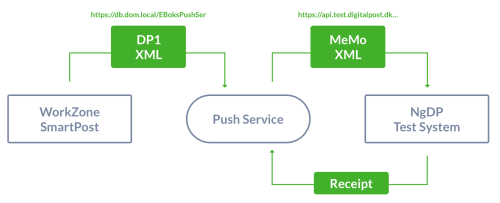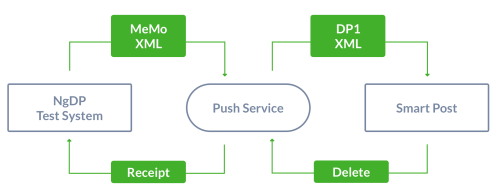Configure SmartPost to use next generation Digital Post (NgDP)
In this article, you can read about how to upgrade SmartPost and WorkZone Mass Dispatch to use NgDP instead of e-Boks in a test environment. The SmartPost integration to NgDP supports both sending and receiving messages.
The NgDP flow
There are only minor changes to the integration between NgDP and SmartPost. The sending and receiving messages functionality has been adjusted to ensure that all systems that use the DigitalPost 1 or 2 interfaces can be upgraded to use NgDP. Additional meta data is now transferred when sending messages to ensure support of NgDP ContactPoints. It is also possible to store the attributes that are associated with materials in the WorkZonedatabase and make them available to the push service when transforming messages to MeMo (message format used by NgDP).
For more information about MeMO, please refer to Det nye meddelelsesformat on the Agency for Digitisation's website (Digitaliseringsstyrelsen).
Sending messages using the SmartPost flow without NgDP
In previous releases, the SmartPost sending messages flow looks as shown below:
SmartPost uses an e-Boks dispatcher configuration to create a connection to the e-Boks endpoint. You can create dispatcher configurations in WorkZone Configurator. See Configure dispatchers.
NgDP flow when sending messages using SmartPost
When using NgDP to send messages from SmartPost, the e-Boks Push Service acts as middle layer that converts outgoing messages to the MeMo format before sending the messages.
The NgDP flow that is used to send messages from SmartPost is illustrated below:
For more information about the WorkZone e-Boks Push Service, see Install and configure WorkZone e-Boks Push Service.
NgDP flow when receiving messages in SmartPost
When receiving messages from the NgDP system, the push service also acts as a middle layer and converts the incoming MeMo messages to DigitalPost 1 XML format that SmartPost can retrieve. When the messages have been handled, SmartPost invokes a DELETE request to the push service, and the push service then sends a receipt to NgDPreceiver system.
Upgrading to NgDP
To upgrade to NgDP, you need to do the following:
- Create a sender/receiver system
- Configure the e-Boks dispatcher to use NgDP
- Configure an e-Boks material to NgDP
- Configure mail boxes for incoming messages
To upgrade an installation from e-Boks to NgDP:
- e-Boks Push Service must be installed. See Install and configure WorkZone e-Boks Push Service.
- The SmartPost e-Boks integration must be working.
- A combined sender and receiver system must be configured in the Agency for Digitisation's administrative portal named Administrativ Adgang portal. You access the Administrativ Adgang portal using the link: https://admin.test.digitalpost.dk/login. For information about using and maintaining the portal, please refer to NgDP Ressourcer on the Agency for Digitisation's website (Digitaliseringsstyrelsen).
- If you use SmartPost to receive incoming emails and have configure mailboxes, you must create the contact hierarchy in the Administrativ Adgang portal.
Create a sender/receiver system
The first step is to create a test sender/receiver system. In relation to upgrading from e-Boks to NgDP, there are some specific requirements to the creation of endpoints and configuration of contact points.
Create endpoints
The system requires an endpoint for receipts (kvitteringer) and an endpoint for messages (MeMo). Both of these endpoints must point to a public HTTPS endpoint that is exposed to the push service. You set up endpoints in the Administrativ Adgang portal.
The protocol must be defined as REST_PUSH.
The receipt endpoint must be declared as:
<base address of push service>/api/MeMoV1/<systemid>/receipt
The message endpoint must be declared as:
<base address of push service>/api/MeMoV1/memos/?system-uuid=<systemid>
When you have set up the system, make a note of the system ID and the authorization header as you will need them when you configure the WorkZone e-Boks dispatcher.
Configure contact points
Your organization must also define a contact point that is used as the sender contact point when sending messages. Contact points are also configured in the Administrativ Adgang portal.
When migrating from e-Boks to NgDP, mailboxes must be migrated to contact points.
A contact point has a GUID that can be retrieved after creation.
When you have defined the contact points and the GUIDs have been created, make a note of the GUIDs as you will them when you configure the WorkZone e-Boks dispatcher and the mailbox mappings.
Configure the e-Boks dispatcher to use NgDP
To configure an existing e-Boks dispatcher to use NgDP, you must change or add values for some parameters. You can also set up a new dispatcher for NgDP instead of modifying an existing dispatcher, and this way have both dispatchers running side by side while you are testing.
- In WorkZone Configurator, go to Process > Process dispatchers.
-
Fill in the following parameters:
| Parameter | Description |
|---|---|
| SenderName | The name of your organization. |
| NgDpGuid | The GUID of your sender/receiver system as defined in the Administrativ Adgang portal. You can see the GUID in the ID field on the Afsender/modtagersystem (Sender/receiver system) page in the Administrativ Adgang portal. |
|
SenderCvr |
|
|
NgDpConactPointGuid |
Your organization's contact point for replies to messages. Fill in this field if you have configured the e-Boks material to allow replies to messages. See Configure an e-Boks material to NgDP. You can see the GUID of your organization's default reply point in the Administrativ Adgang portal on the Kontaktstruktur (Contact hierarchy) page. |
|
NgDpAuthorizationHeader |
he AuthorizationHeader is generated by the Administrativ Adgang portal when the sender/receiver system is defined. |
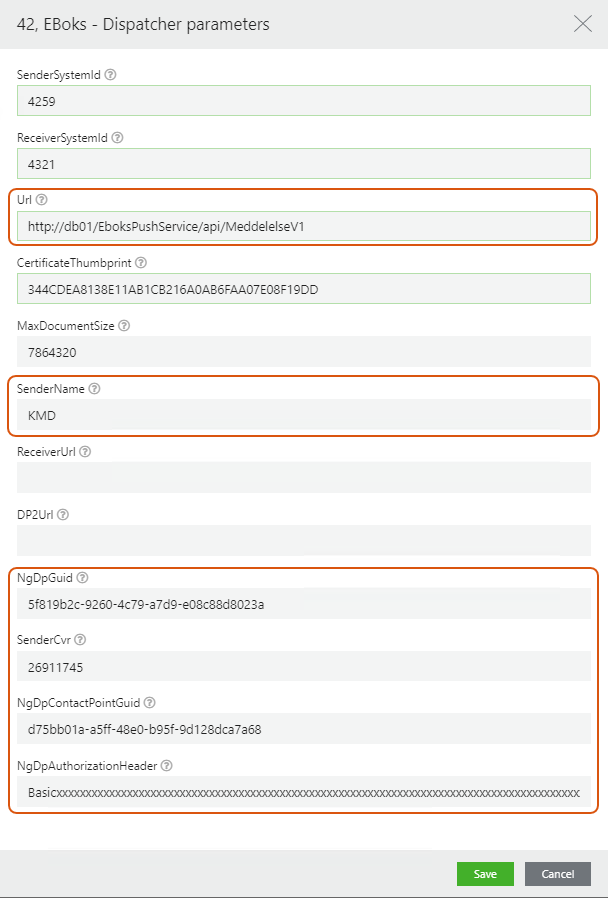
If you have created a new dispatch for NgDP, you must add it to a new or existing dispatch sequence.
See also Configure dispatchers and Configure dispatch sequences.
Configure an e-Boks material to NgDP
NgDP uses the material ID from e-Boks but the configuration that was previously done in the e-Boks Administration Portal is now done in WorkZone.
- In WorkZone Configurator, go to Process > e-Boks materials.
- Create a new material or edit an existing material. The following fields are specific to NgDP:
- Optional title prefix on shipped messages—Add a text that will prefix all titles on messages.
- Permit users to reply— Turn on to allow recipients to reply to messages.
- Messages are mandatory for the receiver—Turn on if the sender is allowed to send mandatory messages.
- Messages are regarded as from a authority—Turn on if the sender is a public authority.
- Messages are legal notifications—Turn on if the sender is allowed to send legal notifications.
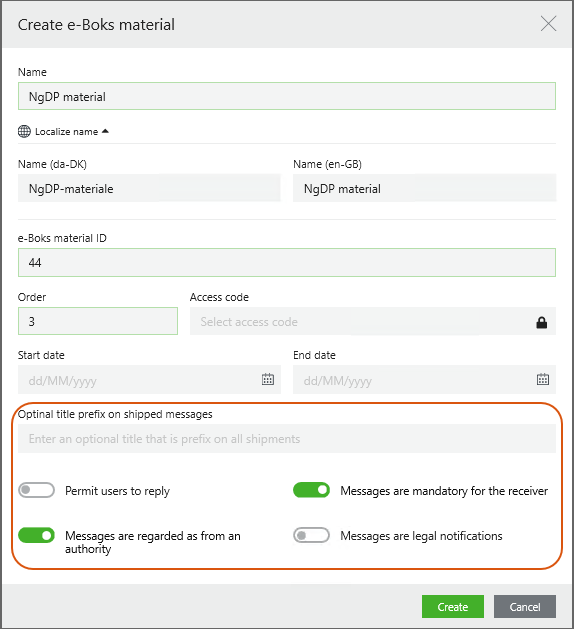
See also Configure e-Boks materials.
Configure mail boxes for incoming messages
If your organization has multiple mailboxes that are mapped to specific cases, you must fill in a new NgDP guid field with the GUID of the corresponding contact point for each mailbox mapping that have been configured. You can see the GUID in the ID field on the Kontaktstruktur (Contact structure) page in the Administrativ Adgang portal.
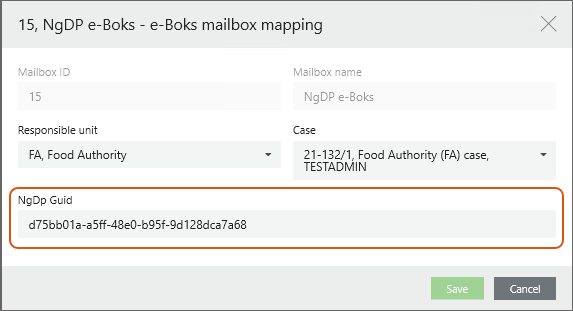
See also Handle e-Boks messages sent to subunits.
